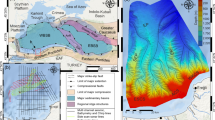Abstract
A high-resolution seismic survey was carried out at the accretionary prism on the continental slope off Vancouver Island, Canada. Two GI-Gun data sets with different source frequency ranges of 50–150 and 100–500 Hz were combined with 4 kHz narrow-beam echosounding data (Parasound). The data allow spatial correlation between a gas hydrate bottom simulating reflector (BSR) and distinct areas of high near-sea-floor reflectivity. An integrated interpretation of the multi-frequency data set provides insight into the regional distribution of tectonically induced fluid migration and gas hydrate formation in the vicinity of ODP Leg 146 Sites 889 and 890. The BSR at the base of the gas hydrate stability field is observed within accreted and deformed sediments, but appears to be absent within bedded slope basin deposits. It is suggested that these basin deposits inhibit vertical fluid flow and prevent the formation of a BSR, whereas the hydraulic conductivity of the accreted sediments is sufficiently high to allow for pervasive gas migration. An elevation of the BSR beneath the flanks of a topographic high is interpreted as an indicator for local upflow of warm fluids along permeable pathways within outcropping accreted sediments. Parasound data reveal discontinuous zones of high reflectivity at or directly beneath the sea floor, which may indicate local cementation of surface sediments. In combination with GI-Gun data, the occurrence of these reflective areas can be related to the location of slope sedimentary basins acting as hydraulic seals. It is proposed that the seals sometimes fail along faults extending beneath the BSR, leading to focused upflow of methane-bearing fluid and the formation of carbonate pavements at the sea floor.
Similar content being viewed by others
Author information
Authors and Affiliations
Additional information
Received: 9 November 1998 / Accepted: 6 April 1999
Rights and permissions
About this article
Cite this article
Zühlsdorff, L., Spieß, V., Hübscher, C. et al. Implications for focused fluid transport at the northern Cascadia accretionary prism from a correlation between BSR occurrence a d near-sea-floor reflectivity anomalies imaged in a multi-frequency seismic data set. Int Journ Earth Sciences 88, 655–667 (2000). https://doi.org/10.1007/s005310050295
Issue Date:
DOI: https://doi.org/10.1007/s005310050295



